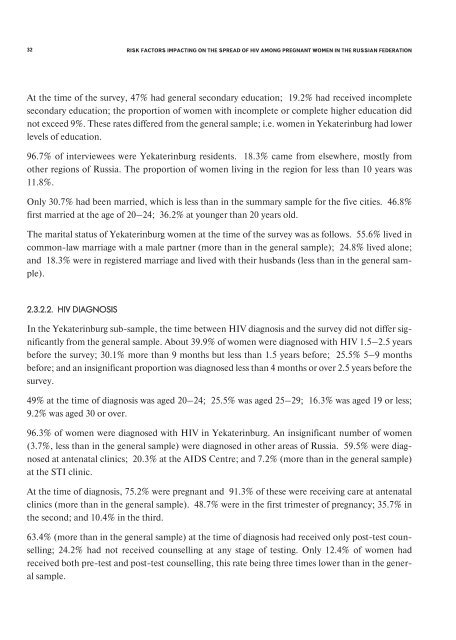risk factors impacting on the spread of hiv among pregnant women ...
risk factors impacting on the spread of hiv among pregnant women ...
risk factors impacting on the spread of hiv among pregnant women ...
You also want an ePaper? Increase the reach of your titles
YUMPU automatically turns print PDFs into web optimized ePapers that Google loves.
32<br />
At <strong>the</strong> time <strong>of</strong> <strong>the</strong> survey, 47% had general sec<strong>on</strong>dary educati<strong>on</strong>; 19.2% had received incomplete<br />
sec<strong>on</strong>dary educati<strong>on</strong>; <strong>the</strong> proporti<strong>on</strong> <strong>of</strong> <strong>women</strong> with incomplete or complete higher educati<strong>on</strong> did<br />
not exceed 9%. These rates differed from <strong>the</strong> general sample; i.е. <strong>women</strong> in Yekaterinburg had lower<br />
levels <strong>of</strong> educati<strong>on</strong>.<br />
96.7% <strong>of</strong> interviewees were Yekaterinburg residents. 18.3% came from elsewhere, mostly from<br />
o<strong>the</strong>r regi<strong>on</strong>s <strong>of</strong> Russia. The proporti<strong>on</strong> <strong>of</strong> <strong>women</strong> living in <strong>the</strong> regi<strong>on</strong> for less than 10 years was<br />
11.8%.<br />
Only 30.7% had been married, which is less than in <strong>the</strong> summary sample for <strong>the</strong> five cities. 46.8%<br />
first married at <strong>the</strong> age <strong>of</strong> 20–24; 36.2% at younger than 20 years old.<br />
The marital status <strong>of</strong> Yekaterinburg <strong>women</strong> at <strong>the</strong> time <strong>of</strong> <strong>the</strong> survey was as follows. 55.6% lived in<br />
comm<strong>on</strong>-law marriage with a male partner (more than in <strong>the</strong> general sample); 24.8% lived al<strong>on</strong>e;<br />
and 18.3% were in registered marriage and lived with <strong>the</strong>ir husbands (less than in <strong>the</strong> general sample).<br />
2.3.2.2. HIV DIAGNOSIS<br />
RISK FACTORS IMPACTING ON THE SPREAD OF HIV AMONG PREGNANT WOMEN IN THE RUSSIAN FEDERATION<br />
In <strong>the</strong> Yekaterinburg sub-sample, <strong>the</strong> time between HIV diagnosis and <strong>the</strong> survey did not differ significantly<br />
from <strong>the</strong> general sample. About 39.9% <strong>of</strong> <strong>women</strong> were diagnosed with HIV 1.5–2.5 years<br />
before <strong>the</strong> survey; 30.1% more than 9 m<strong>on</strong>ths but less than 1.5 years before; 25.5% 5–9 m<strong>on</strong>ths<br />
before; and an insignificant proporti<strong>on</strong> was diagnosed less than 4 m<strong>on</strong>ths or over 2.5 years before <strong>the</strong><br />
survey.<br />
49% at <strong>the</strong> time <strong>of</strong> diagnosis was aged 20–24; 25.5% was aged 25–29; 16.3% was aged 19 or less;<br />
9.2% was aged 30 or over.<br />
96.3% <strong>of</strong> <strong>women</strong> were diagnosed with HIV in Yekaterinburg. An insignificant number <strong>of</strong> <strong>women</strong><br />
(3.7%, less than in <strong>the</strong> general sample) were diagnosed in o<strong>the</strong>r areas <strong>of</strong> Russia. 59.5% were diagnosed<br />
at antenatal clinics; 20.3% at <strong>the</strong> AIDS Centre; and 7.2% (more than in <strong>the</strong> general sample)<br />
at <strong>the</strong> STI clinic.<br />
At <strong>the</strong> time <strong>of</strong> diagnosis, 75.2% were <strong>pregnant</strong> and 91.3% <strong>of</strong> <strong>the</strong>se were receiving care at antenatal<br />
clinics (more than in <strong>the</strong> general sample). 48.7% were in <strong>the</strong> first trimester <strong>of</strong> pregnancy; 35.7% in<br />
<strong>the</strong> sec<strong>on</strong>d; and 10.4% in <strong>the</strong> third.<br />
63.4% (more than in <strong>the</strong> general sample) at <strong>the</strong> time <strong>of</strong> diagnosis had received <strong>on</strong>ly post-test counselling;<br />
24.2% had not received counselling at any stage <strong>of</strong> testing. Only 12.4% <strong>of</strong> <strong>women</strong> had<br />
received both pre-test and post-test counselling, this rate being three times lower than in <strong>the</strong> general<br />
sample.
















